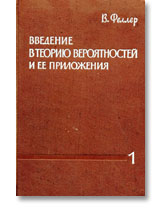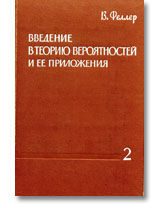|

William Feller
(July 7, 1906, Zagreb - January 14, 1970, New York).
William Feller is a famous mathematician, but paramount is his
role of an apostle of the probabilistic knowledge: he wrote the
famous book "An Introduction to Probability Theory and its
Applications'".
A few quotations from the book "An Introduction to
Probability Theory and its Applications'':
"...Probability is a mathematical discipline whose
aims are akin to those, for example, of geometry or
analytical mechanics. In each field we must be careful to
distinguish three aspects of the theory:
(a) the formal logical content,
(b) the intuitive background, and (c) applications.
The character, and the charm, of the whole structure cannot
be appreciated without considering all three aspects in
their proper relation''.
"...Nowadays small boys betting and shooting dice,
newspapers report on samples of public opinion, and the
magic of statistics embraces all phases of life to the
extent that young girls anxiously watch the statistics of
their chances to get married''.
"...The history of probability (and of mathematics
in general) shows a stimulating interplay of theory and
applications: progress in theory opens new fields of
applications, and each new application creates new
theoretical problems and influences the direction of
research''.


Feller's book have been translated into Russian, Chinese,
Polish, Spanish and Hungarian. The first Russian translation
of Volume I appeared just a year after the appearance of the
book in 1950; also the first Russian translation of Volume
II appeared just a year after the appearance of the book in
1966! Feller himself provided corrections of the English
1966 edition for the 1967 Russian edition of Volume II.
Russian editions:
1. Feller, V.: Vvedenie
v teoriyu veroyatnostei i ee prilozeniya. (Diskretnye
raspredeleniya.) (Russian) [An introduction to probability
theory and its applications. (Discrete distributions.)]
Izdat. Inostrannoj Literatury, Moscow, 1951. 427 pp.
2. Feller, V.: Vvedenie v
teoriyu veroyatnostej i ee prilozheniya. Tom 1. (Russian)
[An introduction to probability theory and its applications.
Vol. 1] Translated from the English by R. L. Dobrusin, A. A.
Juskevic and S. A. Molcanov. Edited by E. B. Dynkin, with an
introduction by A. N. Kolmogorov. Second edition, reprinted
Izdat. ``Mir'', Moscow 1964 and 1967 (reprinted 1964
edition). 498 pp.
3. Feller, V.: Vvedenie v
teoriyu veroyatnostej i ee prilozheniya. Tom 2. (Russian)
[An introduction to probability theory and its applications.
Vol. 2] Translated from the English by Ju. V. Prohorov Izdat.
``Mir'', Moscow 1967 752 pp.
4. Feller, V.: Vvedenie v
teoriyu veroyatnostej i ee prilozheniya. Tom 1. (Russian)
[An introduction to probability theory and its applications.
Vol. 1] Translated from the third English edition and with a
preface by Yu. V. Prokhorov. Second edition. With a preface
by A. N. Kolmogorov. ``Mir'', Moscow, 1984. 528 pp.
5. Feller, V.: Vvedenie v
teoriyu veroyatnostej i ee prilozheniya. Tom 2. (Russian)
[An introduction to probability theory and its applications.
Vol. 2] Translated from the second English edition and with
a preface by Yu. V. Prokhorov. Second edition. ``Mir'',
Moscow, 1984. 752 pp.


From the Introduction to the second Russian edition to
Feller's book (Volume I, Moscow
1964), written by A.N. Kolmogorov:
"The first edition of Feller's book already obtained a
widespread approval in the USSR. Now we bring to the
reader's attention the translation of the second English
edition, improved and added to by the author in many
details. ...It is precisely this choice of material which
enables Feller's book to occupy an independent place in the
literature on probability theory. ...By the choice of
problems Feller brings to light their solving by ``direct'',
and specifically probabilistic means. This tendency to see
behind analytical transformations their "probabilistic"
sense, belongs to the most valuable features of Feller's
book. Deserving our attention is also the author's effort in
the book in clearly illustrating the character of effects of
probabilistic laws on carefully chosen examples. In many
cases the author manages to introduce the reader into really
interesting questions of comparing statistical data and
probabilistic theory of events''.
|


